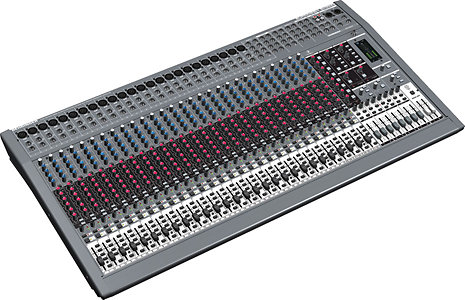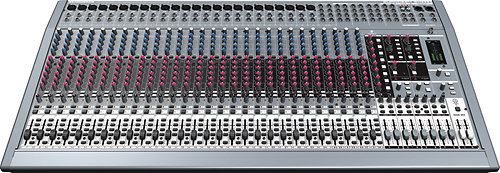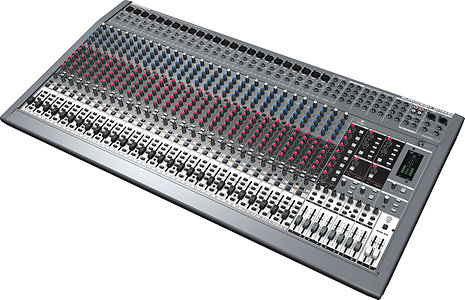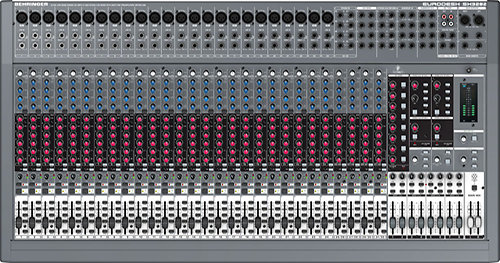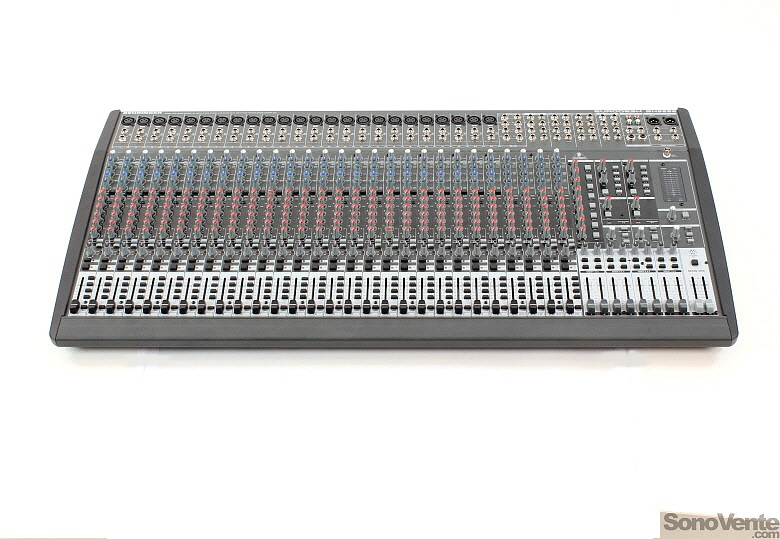Behringer - SX3282 EURODESK
Ce produit n'est plus disponible à la vente
Ces modèles en stock pourraient vous intéresser :
517 €
dont éco-part : 0,50 €
Garantie 3 ans
Console de Mixage Analogique
Console de Mixage 32 Canaux, 24 Entrées Monos + 4 Entrées Lines, 8 Sous-Groupes, Idéal pour Studio ou Scène
ARTICLE N° 20912
Caractéristiques
-
Console de Mixage Pro 32 Canaux.
-
Idéal pour Studio ou Scène
-
24 préamplis micros XENYX avec alimentation fantôme +48 V.
-
4 entrées ligne stéréo.
-
Egaliseur “British EQ“ néo-classique 4 bandes (stéréo), et égaliseur 3 bandes dont médium semi-paramètrique sur les canaux mono.
-
8 sous-groupes avec contrôle de panoramique indépendant.
-
Fonctions Solo, Main et inserts.
-
Filtre passe-bas, Mute, Solo/PFL, sous-groupe et routing Main assignable par canal.
-
8 départs d'effets par canal dont 4 pre/post fader.
-
4 retours auxiliaires stéréo.
-
Fonction Solo-In-Place dotée d'un PFL, Talkback, section casques et monitor.
-
Inserts sur tous les canaux mono, sous-groupes et Main.
-
Entrées et sorties Main symétriques.
-
Led mètre 13 segments sur le Main mix.
-
Curseurs de 60 mm à longue durée de vie et potentiomètres clos.
-
Alimentation interne à découpage (100 - 240 V˜).
Présentation
La réputation de la série Eurodesk n'est plus à faire. Cette série de consoles conçue pour le studio et pour la scène a gravé depuis longtemps ses lettres de noblesse.
Pour aller plus loin...
La réputation de la série Eurodesk n'est plus à faire. Cette série de consoles conçue pour le studio et pour la scène a gravé depuis longtemps ses lettres de noblesse. La qualité sans compromis de ces consoles a très rapidement séduit nombre de musiciens et ingénieurs du son. Profitant des technologies les plus avancées de Behringer, ces consoles offrent plus que jamais un rapport qualité/prix inégalable.- Console analogique 32 canaux.
* Ultra-low noise, high-headroom analog mixer for studio, live, front-of-house, monitor, corporate and touring audio applications
* 24 state-of-the-art XENYX Mic Preamps with switchable +48 V phantom power plus 4 stereo Line inputs
* Neo-classic "British" 4-band EQ (stereo channels) and 3-band EQ with semi-parametric mid band (mono channels) for warm and musical sound
* 8 subgroups with independent Pan controls, Solo and Main functions and insert connections
* Clip and -20 dB LEDs plus Low Cut, Mute, Solo/PFL, Subgroup and Main routing switches on all channels
* 8 Aux sends per channel: 4 pre/post fader switchable for flexible routing
* Main Aux sends with Level controls and Solo functions
* 4 multi-functional stereo Aux returns featuring Level and Balance controls, Solo and extensive routing functions
* Solo-In-Place with PFL function plus full-featured Talkback, Phones and Monitor section
* Inserts on all mono channels, subgroups and main
* Balanced inputs and Main outputs for highest signal integrity
* High-precision, 13-segment LED meter for main mix
* Long-wearing 60-mm logarithmic-taper faders and sealed rotary controls
* Internal autorange power supply for maximum flexibility (100 - 240 V~), noise-free audio, superior transient response plus low power consumption for energy saving
* High-quality components and exceptionally rugged construction ensure long life
* Conceived and designed by BEHRINGER Germany
If you're looking for old-school analog handling in a package armed to the teeth with modern reliability, the search is over. This mixer's British EQ, 24 mic inputs (each with its own built-in studiograde XENYX preamp), 8 stereo inputs and 8 buses give you enough leeway to craft the recording of your dreams or create the perfect mix for a live show.
What the heck is "British EQ"?
British EQ is a smashing thing to have on your side when you start reaching for those channel equalization knobs at a live concert or in the studio.
The EQ's on British consoles from the 60s and 70s are what many engineers believe does their sound the best justice. When it comes to tweaking your sound, they're kind, gentle and above all, musical. It's like drinking a fine scotch instead of fortified wine—or maybe receiving a warm hug instead of a kick to the crotch.
British EQ's distinct configuration of wider curves/lower Q and harmonic phase characteristics allows you to add or subtract EQ more generously than you can with conventional EQ circuit designs. When you add low midrange, you get a firmer sound instead of a nasty bonk. When you back high frequencies off a bit, treble backs off just a hair instead of turning muffled.
The Ins and Outs
Some manufacturers make what they call 32-input mixers that count features like CD/TAPE IN as an input. But the SX3282 really gives you 24 mono channels and four stereo channels (with two 1/4" inputs apiece—an additional 8 inputs), making it easy to accommodate a wide variety of studio or live performance configurations. That means you can connect up to 24 microphones or other mono instruments and up to four stereo instruments (keyboards, for example). You also get eight buses, allowing you to assign multiple channels—say all the mics on a drum kit or all the backup singers' mics—to a single fader.
Best of all, you don't need a black belt in engineering to operate the SX3282. The mono channels are grouped along two-thirds of the board, featuring dials in uniform primary colors (Gain in white; EQ in blue; AUX in red; Pan in black). Sub groups are located next door to the Main and Mono faders in the bottom right corner. Directly above, there's a handy built-in talkback mic that sends signal to your AUX 1-2 monitors via a push button, as well as a multi-purpose 13-LED master level meter to give you a dynamic visual gauge of the selected output.
The SX3282's intuitive patch bay makes it equally at home in the club or studio. You get two balanced XLR MAIN outputs as well as a two 1/4" TRS MAIN outs. There's also a 1/4" MONO OUT (perfect for a subwoofer output). Eight SUBGROUP OUT jacks allow you to send your buses to an external recording device. This section also includes AUX SEND jacks for connection to monitors, CD/ TAPE input and output jacks, and FX send/return jacks for use with outboard effects processors. Directly below, you'll fi nd the 1/4" headphone/ control room out jack.
A Million Ways To Change The Channel
At the top of each mono channel, you'll find both a balanced XLR input with a XENYX mic preamp and a 1/4" input. A phantom power switch located on the back near the main power switch accommodates condenser mics. Each mono channel has a 3-band EQ with semi-parametric mids (giving you control of the Mid level and a sweepable frequency with a boost or cut of 15dB) and a Trim control for adjusting input gain via a Level Set LED. A Low Cut button eliminates the frequencies where unwanted infrasonics such as mic handling noise occur. The eight AUX dials control the volume of the AUX SEND 1/4" output signals (more on that below).
Stereo channels feature the same functions, but a with dual 1/4" inputs and a different EQ. Instead of sweepable mids, stereo channels feature High Mid and Low Mid dials, both with bell center frequencies set at 8 kHz and 800 Hz, respectively. This is especially useful for EQ'ing the critical midrange frequency content found in keyboard signals.
Near every mono channel's fader you'll find a 1-2, 3-4, 5-6, 7-8 and MAIN button. By engaging the MAIN button, the signal is sent to the main mix. Or, if you engage the 1-2 button, the channel becomes part of a bus. Twist the PAN control all the way to the left to assign it to Sub 1, or all the way to the right for Sub 2. The same principle applies to the 3-4, 5-6 and 7-8 buttons.
A Mute button with accompanying LED cuts the signal from the channel, and a Clip LED helps you dial in a distortion-free post-EQ signal. The Solo button on individual channels routes the subgroup signal to the solo bus or Pre-Fader Listen—depending on whether the signal has been included in a subgroup.
Finally, each of the eight buses feature an independent fader, Solo switch, and Left and Right buttons to assign them to Left or Right stereo channels.
Hitch your art to the AUX
The SX3482 has eight AUX SEND outputs as well as eight AUX return inputs, giving you more routing options than a Los Angeles road map. AUX SEND 1-8 allow you to send the signal governed by an individual channel to an outboard FX unit or EQ. Meanwhile, the AUX returns can be thought of as eight extra line inputs working as four stereo pairs. You can apply up to 20 dB of gain to these inputs. AUX returns 1, 2, 7 and 8 allow returning FX to be sent to tape, and, along with 5 and 6, are also good for cuing artists via headphones. AUX returns 3 and 4 are always assigned to the main bus.
Buy it now. Teach your great grandkids how to run it.
BEHRINGER mixers last and last. We use top quality parts such as longwear faders, sealed rotary controls and premium circuit boards. We have 20 years of experience figuring out how to compensate for clumsy loadins, spilled drinks, crazed guitarists and millions of road miles. The result is a mixer you can count on day after day and night after night.
Take On The World
Not every town on the planet uses the same voltage common in yours. Unfortunately, this sometimes doesn't occur to jet-setting sound technicians until they're 5,000 miles from home. With the SX3282, this is never an issue. The internal auto-range power supply can run on anything from 100 to 240 V with noise-free audio, top-quality transient response and low power consumption.
Why do you need this mixer?
• Built-in pristine XENYX mic preamps
• British-style EQ dials give you the sound and control preferred by top studio engineers
• Awesomely complete I/O – everything from bus inserts to mono output
* Ultra-low noise, high-headroom analog mixer for studio, live, front-of-house, monitor, corporate and touring audio applications
* 24 state-of-the-art XENYX Mic Preamps with switchable +48 V phantom power plus 4 stereo Line inputs
* Neo-classic "British" 4-band EQ (stereo channels) and 3-band EQ with semi-parametric mid band (mono channels) for warm and musical sound
* 8 subgroups with independent Pan controls, Solo and Main functions and insert connections
* Clip and -20 dB LEDs plus Low Cut, Mute, Solo/PFL, Subgroup and Main routing switches on all channels
* 8 Aux sends per channel: 4 pre/post fader switchable for flexible routing
* Main Aux sends with Level controls and Solo functions
* 4 multi-functional stereo Aux returns featuring Level and Balance controls, Solo and extensive routing functions
* Solo-In-Place with PFL function plus full-featured Talkback, Phones and Monitor section
* Inserts on all mono channels, subgroups and main
* Balanced inputs and Main outputs for highest signal integrity
* High-precision, 13-segment LED meter for main mix
* Long-wearing 60-mm logarithmic-taper faders and sealed rotary controls
* Internal autorange power supply for maximum flexibility (100 - 240 V~), noise-free audio, superior transient response plus low power consumption for energy saving
* High-quality components and exceptionally rugged construction ensure long life
* Conceived and designed by BEHRINGER Germany
If you're looking for old-school analog handling in a package armed to the teeth with modern reliability, the search is over. This mixer's British EQ, 24 mic inputs (each with its own built-in studiograde XENYX preamp), 8 stereo inputs and 8 buses give you enough leeway to craft the recording of your dreams or create the perfect mix for a live show.
What the heck is "British EQ"?
British EQ is a smashing thing to have on your side when you start reaching for those channel equalization knobs at a live concert or in the studio.
The EQ's on British consoles from the 60s and 70s are what many engineers believe does their sound the best justice. When it comes to tweaking your sound, they're kind, gentle and above all, musical. It's like drinking a fine scotch instead of fortified wine—or maybe receiving a warm hug instead of a kick to the crotch.
British EQ's distinct configuration of wider curves/lower Q and harmonic phase characteristics allows you to add or subtract EQ more generously than you can with conventional EQ circuit designs. When you add low midrange, you get a firmer sound instead of a nasty bonk. When you back high frequencies off a bit, treble backs off just a hair instead of turning muffled.
The Ins and Outs
Some manufacturers make what they call 32-input mixers that count features like CD/TAPE IN as an input. But the SX3282 really gives you 24 mono channels and four stereo channels (with two 1/4" inputs apiece—an additional 8 inputs), making it easy to accommodate a wide variety of studio or live performance configurations. That means you can connect up to 24 microphones or other mono instruments and up to four stereo instruments (keyboards, for example). You also get eight buses, allowing you to assign multiple channels—say all the mics on a drum kit or all the backup singers' mics—to a single fader.
Best of all, you don't need a black belt in engineering to operate the SX3282. The mono channels are grouped along two-thirds of the board, featuring dials in uniform primary colors (Gain in white; EQ in blue; AUX in red; Pan in black). Sub groups are located next door to the Main and Mono faders in the bottom right corner. Directly above, there's a handy built-in talkback mic that sends signal to your AUX 1-2 monitors via a push button, as well as a multi-purpose 13-LED master level meter to give you a dynamic visual gauge of the selected output.
The SX3282's intuitive patch bay makes it equally at home in the club or studio. You get two balanced XLR MAIN outputs as well as a two 1/4" TRS MAIN outs. There's also a 1/4" MONO OUT (perfect for a subwoofer output). Eight SUBGROUP OUT jacks allow you to send your buses to an external recording device. This section also includes AUX SEND jacks for connection to monitors, CD/ TAPE input and output jacks, and FX send/return jacks for use with outboard effects processors. Directly below, you'll fi nd the 1/4" headphone/ control room out jack.
A Million Ways To Change The Channel
At the top of each mono channel, you'll find both a balanced XLR input with a XENYX mic preamp and a 1/4" input. A phantom power switch located on the back near the main power switch accommodates condenser mics. Each mono channel has a 3-band EQ with semi-parametric mids (giving you control of the Mid level and a sweepable frequency with a boost or cut of 15dB) and a Trim control for adjusting input gain via a Level Set LED. A Low Cut button eliminates the frequencies where unwanted infrasonics such as mic handling noise occur. The eight AUX dials control the volume of the AUX SEND 1/4" output signals (more on that below).
Stereo channels feature the same functions, but a with dual 1/4" inputs and a different EQ. Instead of sweepable mids, stereo channels feature High Mid and Low Mid dials, both with bell center frequencies set at 8 kHz and 800 Hz, respectively. This is especially useful for EQ'ing the critical midrange frequency content found in keyboard signals.
Near every mono channel's fader you'll find a 1-2, 3-4, 5-6, 7-8 and MAIN button. By engaging the MAIN button, the signal is sent to the main mix. Or, if you engage the 1-2 button, the channel becomes part of a bus. Twist the PAN control all the way to the left to assign it to Sub 1, or all the way to the right for Sub 2. The same principle applies to the 3-4, 5-6 and 7-8 buttons.
A Mute button with accompanying LED cuts the signal from the channel, and a Clip LED helps you dial in a distortion-free post-EQ signal. The Solo button on individual channels routes the subgroup signal to the solo bus or Pre-Fader Listen—depending on whether the signal has been included in a subgroup.
Finally, each of the eight buses feature an independent fader, Solo switch, and Left and Right buttons to assign them to Left or Right stereo channels.
Hitch your art to the AUX
The SX3482 has eight AUX SEND outputs as well as eight AUX return inputs, giving you more routing options than a Los Angeles road map. AUX SEND 1-8 allow you to send the signal governed by an individual channel to an outboard FX unit or EQ. Meanwhile, the AUX returns can be thought of as eight extra line inputs working as four stereo pairs. You can apply up to 20 dB of gain to these inputs. AUX returns 1, 2, 7 and 8 allow returning FX to be sent to tape, and, along with 5 and 6, are also good for cuing artists via headphones. AUX returns 3 and 4 are always assigned to the main bus.
Buy it now. Teach your great grandkids how to run it.
BEHRINGER mixers last and last. We use top quality parts such as longwear faders, sealed rotary controls and premium circuit boards. We have 20 years of experience figuring out how to compensate for clumsy loadins, spilled drinks, crazed guitarists and millions of road miles. The result is a mixer you can count on day after day and night after night.
Take On The World
Not every town on the planet uses the same voltage common in yours. Unfortunately, this sometimes doesn't occur to jet-setting sound technicians until they're 5,000 miles from home. With the SX3282, this is never an issue. The internal auto-range power supply can run on anything from 100 to 240 V with noise-free audio, top-quality transient response and low power consumption.
Why do you need this mixer?
• Built-in pristine XENYX mic preamps
• British-style EQ dials give you the sound and control preferred by top studio engineers
• Awesomely complete I/O – everything from bus inserts to mono output
Accessoires
Behringer - SX3282 EURODESK
Behringer - SX3282 EURODESK
517 €
dont éco-part : 0,50 €
Garantie 3 ans
Plein feu sur
La très célèbre marque BEHRINGER n'est plus à présenter ! La DJX 750 et la nouvelle DJX 900, les nouvelles tables de mixage NOX et la DDM 4000, les enceintes amplifiées et passives de la série B, les amplis EP, EPQ et EPX, les très compétitives consoles Behringer XENYX, les enceintes monitors de la série TRUTH, les sonos portables EPA... De la qualité, un prix imbattable !


